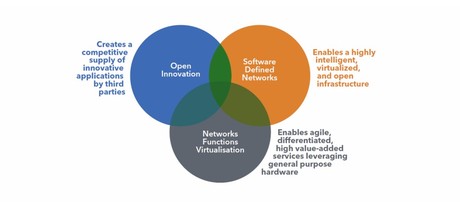Opening up 5G

SDN/NFV will help achieve the vision of a truly converged, next-generation mobile infrastructure.
The next mobile generation (5G) is not just redefining mobile services — it is also ushering in an era of open technologies that are transforming the telecommunications industry.
Software-defined networking (SDN) and network functions virtualisation (NFV) represent the future in telecommunications, by virtualising the infrastructure and services to offer unprecedented agility, intelligence and openness.
For the past five years, SDN and NFV have been progressing due to unique collaboration between standards organisations and open-source communities that together are reshaping how new technology may be adopted.
Innovative industry groups such as the ETSI NFV ISG and the Open Networking Foundation established the reference architectures, validated use cases and reshaped the requirements for open-source building blocks integral to NFV and SDN.
In response, in 2012, The Linux Foundation introduced the first large-scale, open-source networking platform, OpenDaylight. The open SDN Controller Framework has since established a broad technical community; over 900 developers contributed to the current release. OpenDaylight has spawned commercial offerings supporting hundreds of millions of subscribers around the globe.
SDN and NFV have emerged as critical technologies for 5G to enable a wide range of data-driven applications that have been written about extensively on OpenDaylight, including mobile broadband, the Internet of Things (IoT), mobile-to-mobile (M2M), etc.
To enable such a diverse range of end-user applications, the SDN/NFV management and control model must become much more highly scalable, intelligent, flexible and open than ever before.
Many of the telecommunications industry’s most innovative and proactive operators and solution providers have undertaken the challenge to redefine the service delivery life cycle as a result. This requires unique collaboration among the network management standards bodies, SDN/NFV industry organisations and the open source community.
Over the past year, there have been a number of open-source initiatives announced to address the challenges of network orchestration and automation, including the ETSI Open Source MANO (OSM) project, Linux Foundation OPEN-O project, AT&T’s open source ECOMP (Enhanced Control, Orchestration, Management, and Policy) project (also with The Linux Foundation), among others.
Groundbreaking collaboration with ONAP
While having multiple alternatives offers the potential for competing approaches that the market will select based on their individual innovations and merits, the potential for fragmentation and dilution of investment looms. That is why the principals in the OPEN‑O and open-source ECOMP communities announced a groundbreaking effort to converge, resulting in the introduction of the Open Network Automation Platform (ONAP), under The Linux Foundation.
On Day 1, ONAP founding members represented just under 40% of the world’s mobile subscribers, and virtually all of the leading solution providers. Such critical mass is essential, considering the need to forge a common, industry-wide, open platform for service automation and orchestration.
ONAP intends to address the entire service-delivery life cycle, including:
- Service Design — A model-driven approach that minimises software development for new and derivative services.
- OSS/BSS/UI Integration — Open orchestration raises an industry debate about which OSS functions will be captured in the platform, versus existing back-end approaches.
- Virtualised Network Function (VNF) Orchestration — VNFs represent the building blocks for composite services; ONAP is participating in an industry-wide effort to streamline VNF onboarding, establishing a common packaging format to enable many to participate in the emerging open SDN/NFV ecosystem.
- Connectivity Services Orchestration — For end-to-end service delivery, a flexible set of capabilities is needed to achieve orchestration across a wide range of network domains and technologies.
- Service Management — Rounding out the platform includes a rich set of policy management, analytics and related functions to enable a more intelligent service delivery life cycle.
The ONAP project leverages The Linux Foundation’s best practices refined by over 25 years of enabling some of the world’s most important open-source projects. ONAP is a truly global project, featuring an open governance model forum to discuss architecture initiatives. It makes for a healthy blend between operators and vendors and top-down/bottom-up decision-making.
The project was announced in February 2017, and is currently in the process of release planning and initial ramp-up.
As 5G rapidly approaches reality, it is imperative for standards bodies, industry groups and the open-source community to undertake a highly collaborative approach for a pragmatic technology adoption life cycle for SDN/NFV. By working together, use cases may be prioritised to guide development, requirements and implementation may be validated and the many trade-offs that arise may be thoroughly considered.
Working in a neutral and open forum, an inclusive and open community will catalyse the cultivation of the open ecosystem that enables many to benefit.
The future of telecommunications is currently being reshaped by SDN/NFV, with 5G among the first projects to realise the vision of a truly converged, next-generation mobile infrastructure.
RFUANZ report: setting the frequency for success in 2025
Last year brought a lot of internal change for RFUANZ, but the association has hit the ground...
ARCIA update: an extended event calendar for 2025
With the addition of Tasmanian events and a conference in Adelaide in September, 2025 will see...
ARCIA update: plans for 2025
ARCIA will be holding a mixture of workshop, conference and networking events in 2025, in the...





